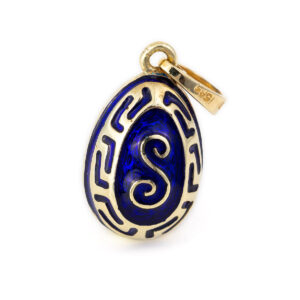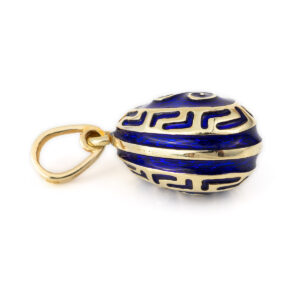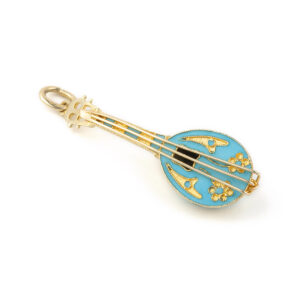Meander Egg Pendant – 14k Gold and Blue Enamel
730,00€The pendant is embellished with Meander design.
Used as a charm or as a pendant.
Pick up a beautiful gift inspired by the majestic art of Fabergé!
Made in 14k yellow gold and blue enamel
Fabergé egg is a jeweled egg created by the House of Fabergé, in St. Petersburg, Imperial Russia. Virtually all were manufactured under the supervision of Peter Carl Fabergé between 1885 and 1917,[citation needed] the most famous being the 50 “Imperial” eggs, 43 of which survive, made for the Russian Tsars Alexander III and Nicholas II as Easter gifts for their wives and mothers. The first Fabergé egg was crafted for Tsar Alexander III, who had decided to give his wife, the Empress Maria Feodorovna, an Easter egg in 1885. Peter Carl Fabergé was a Russian jeweller best known for the famous Fabergé eggs made in the style of genuine Easter eggs, using precious metals and gemstones. He’s the founder of the famous jewelry legacy House of Fabergé.
Meander or Meandros design, one of the most historic symbols of the Greek World, also called Greek Key and symbolizes long life and eternity.
As in all handmade items there may be small differences in weight and dimensions and this is what makes them unique and precious.
14k Yellow Gold Greek Bouzouki Charm with Turquoise Enamel
730,00€Greek Bouzouki Charm with turquoise enamel decorated with rosette motifs.
Made in 14k yellow gold.
Used as a charm or as a pendant.
Handmade in Greece.
Design inspired by the Greek tradition.
Explore Heritage Collection
History
The Greek bouzouki is a plucked musical instrument of the lute family, called the thabouras or tambouras family. The tambouras existed in ancient Greece as the pandura, and can be found in various sizes and shapes. The bouzouki and the baglamas are the direct descendants. The bouzouki arrived in Greece following the 1919–1922 war in Asia Minor and the subsequent population exchange between Greece and Turkey. The early bouzoukia mostly had three courses. At the end of the 1950s, four-course (tetrachordo) bouzoukia started to gain popularity. The four-course bouzouki was made popular by Manolis Chiotis. Manolis Chiotis was a Greek rebetiko and laiko composer, singer, and bouzouki player. He is considered one of the greatest bouzouki soloists of all time.






